Browning Pass, British Columbia
Text and images by Ken Ashman © 2019. All rights reserved.
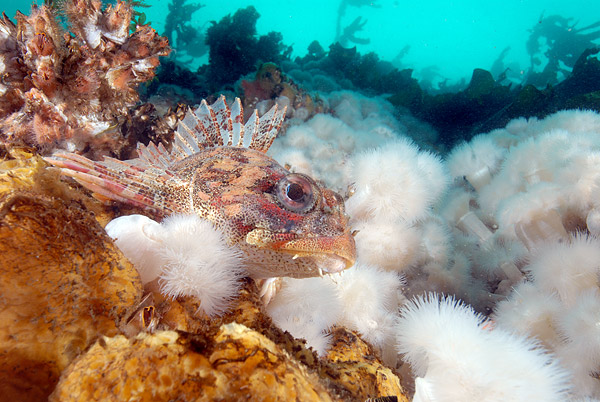
A Red Irish Lord H. hemilepidotus at Browning Wall.
Click the thumbnails below for a larger image. Use you browser back button to return.
Browning Pass is a remote current-swept channel, between Nigei Island and Balaklava Island, at the northern-most end of Vancouver Island, BC. The region has some of the most amazing and thick-packed invertebrate marine life on planet Earth. The beauty here takes my breath away.
In March, of 2019, I had the great pleasure to return to this amazing place. I joined my friend Richard Salas of Ask Photography for a two week photo trip.
Our home base was Hurst Island, at God's Pocket Resort. GPR is the only human imprint on the thickly forested island. Bald eagles perching atop the pines are a constant sight here. During our stay a group of five orcas came into the cove, swimming literally inches from the GPR dock. The sublime vision of cormorants diving for fish in the cove at dawn is emblazed on my memory.
God's Pocket Resort
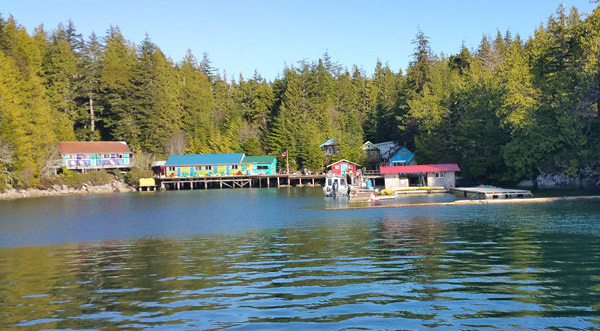
The most important element of a dive trip is the dive operation. If that part isn't right, nothing else matters. The GPR dive operation was A+. Our boat captain Dan and our divemaster Chris were true professionals. They are experts on diving this region, and they were the engineers that made GPR run during our stay. They are also awesome guys and great to talk to.
After the dive operation, it's all about the food. I am happy to report the amazing meals served up on our trip also get a perfect A+. Chef Bee is exceptional. She has great skills with a wide variety culinary styles, and all our meals were fabulous!
Our vibrant host Yolane took care of our every need during our stay. Yolane is a wonderful spirit, and her joy permeates God's Pocket. Her bright smile and cheerfulness made our stay amazing.
God's Pocket Resort is comfy, well equipped, and has everything needed for a great cold water diving adventure.
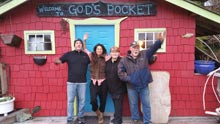
Dan, Yolane, Bee, & Chris
|
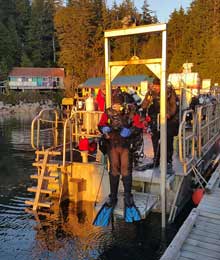
The dive boat has an elevator!
|
|
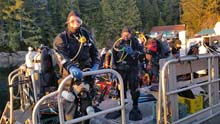
As the sun sets divers prepare for a night dive in the GPR cove.
|
|
Nine diving days, twenty four dives
My basic approach is to use as many camera and light positions as I can. If I find a good subject I take a lot of shots, from a lot of perspectives. This trip I ended up with 1600+ keepers (i.e. in focus, decent exposure, etc.) after 24 dives.
I take 10 to 25 shots of any "good" subject I come across. I experiment with strobe positions, and dialing in my lighting. This trip I used long (3 ft.) arms - so my max "wing span" was near 7 ft! Long arms give me a lot of flexibility to position my strobes and get the light how I want it.
After I download to my laptop, I look at all the images of the day and try to pick the "best" of each subject. These are the shots I present here.
My conception of best is entirely subjective. It's something I see in my mind's eye and then try to achieve with my camera. I try to combine the ambient light with the light from my strobes as seamlessly as I can. I try to balance all the light in the frame, so it all feels natural. The more natural the light the better.
As for ratios, if I take 25 shots of a subject I'm happy ending up with two good ones. Sometimes I get more. Sometimes I get none - lol. My "secret" if I have one is to take lots and lots of shots, and use as many camera angles and lighting ideas as I can.
Now without further ado, here are 48 of my underwater images from my trip to Browning Pass in late March / early April, 2019.
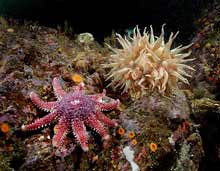
A Sunflower Star and large anemone at Lucan Chute.
|
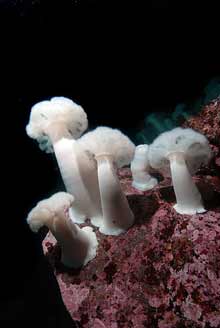
A 3 ft. Giant Plumose Anemone
among smaller sisters.
|
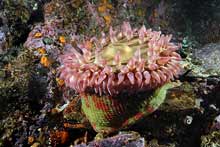
Urticina crassicornis
|
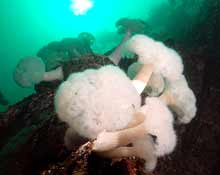
Looking straight up a wall at
Giant Plumose Anemones
Metridium farcimen.
|
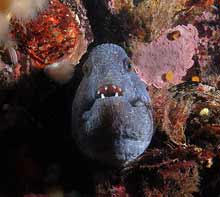
A female Wolf Fish
Anarrhichthys ocellatus.
|
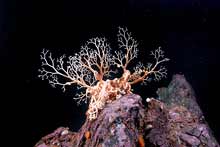
A Basket Star
Gorgonocephalus eucnemis
|
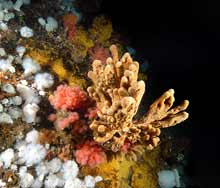
Finger Sponge
Isodictya quatsinoensis
|
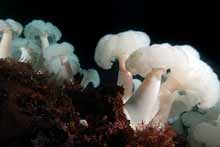
Metridium farcimen
|
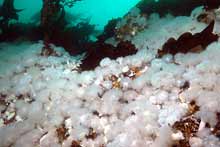
Metridium senile
covering the wall at Snow Bowl.
|
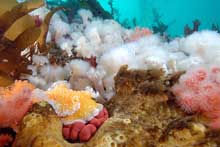
A Lemon Peel branch
on the reef at Seven Tree.
|
|
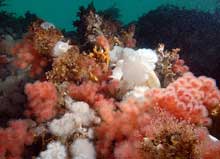
Soft Corals and Metridiums
and Hydroids on the reef.
|
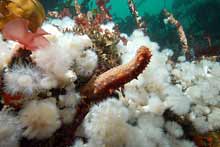
A Red Sea Cucumber
Parastichopus californicus
among many Metridiums
|
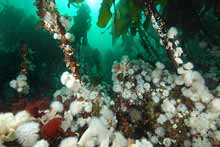
Metridium senile anemones
on kelp at Snowball.
|
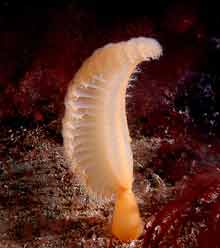
Orange Sea Pen
Ptilosarcus gurneyi
|
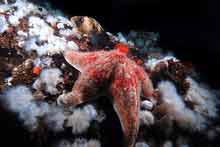
A Leather Star and Rockfish
among Metridiums.
(My favorite shot of the trip.)
|
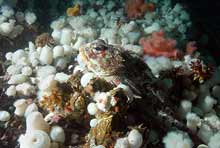
A Red Irish Lord
on the wall at Aquarium.
|
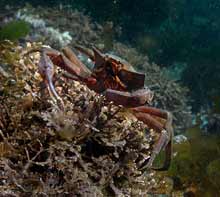
A Kelp Crab
Pugettia producta
|
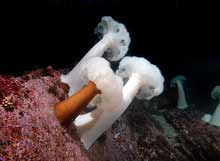
More Giant Plumose Anenomes
|
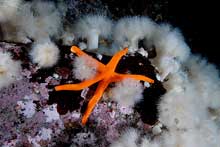
Blood Star Henricia Leviuscula
among Metridium seniles
|
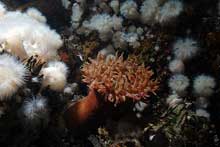
A Giant Brown Anenome
|
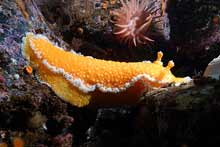
The Lemon Peel nudibranch
Tochuina tetraquetra
|
|
Seven Tree dive site, north end of Browning Pass
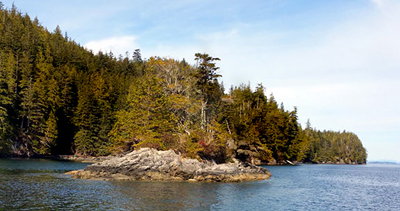
Red Irish Lords are abundant at Seven Tree, as are many varieties of sculpins and rockfish. Nudibranchs are everywhere. Vast numbers of tightly-packed metridiums cover the steep walls. Sponges and sea stars of many varieties abound. Giant Pacific Octopus and Wolf Eels were seen on most every dive here.
Seven Tree is one of my all-time favorite places in the world to dive.
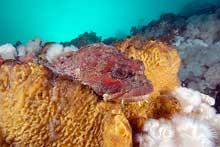
A Red Irish Lord
H. hemilepidotus
on a yellow sponge at Seven Tree.
|
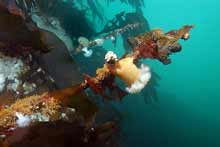
At Browning Pass life covers everything.
|
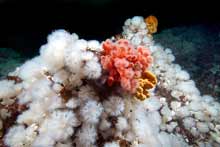
Soft Corals atop Metridiums.
|
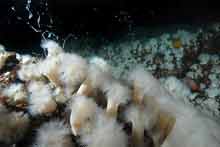
Metridium senile anemones spawning.
| 9
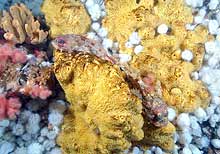
Two Irish Lords on a sponge.
|
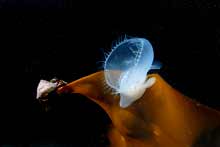
A Hooded Nudibranch
Melibe leonine
rears back to scoop water.
|
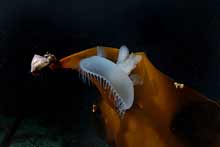
Mid scoop.
|
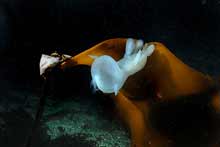
A Hoodie with a mouthful.
The rhinosphores on it's head and the cerata along it's back are prominent.
|
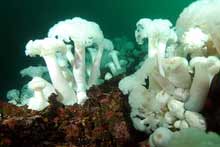
Giant Plumose Anemones
Metridium farcimen
|
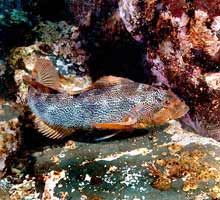
Female Kelp Greenling Hexagrammos decagrammus
|
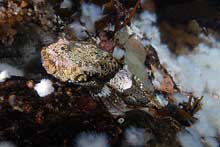
14 inch Buffalo Sculpin
Enophrys bison |
|
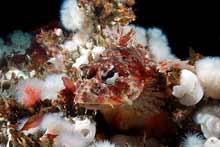
Almost invisible
on the wall at Seven Tree.
|
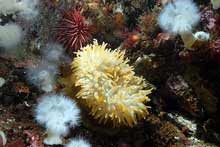
A Yellow Anemone
on Seven Tree wall.
|
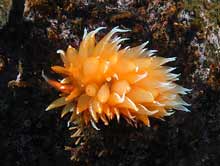
Dirona pellucida
|
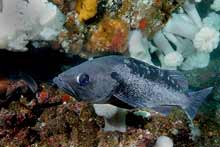
A Blue Rockfish
|
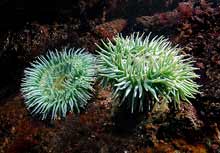
Giant Green Anenomes Anthopleura xanthogrammica
|
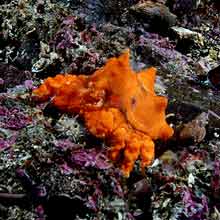
Puget Sound King Crab
(a young juvenile.)
|
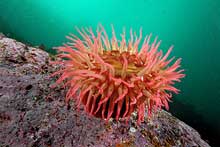
To achieve this lighting one strobe is high and behind, pointing back from 11 o'clock. The second strobe is a fill light coming from 3 o'clock.
|
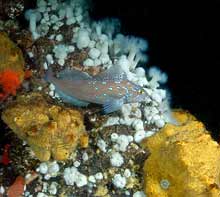
Male Kelp Greenling
Hexagrammos decagrammus
|
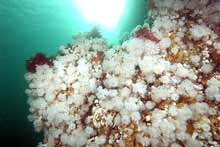
Metridiums blanketing Seven Tree
|
|
Diving conditions overall turned out to be just about as good as it gets. Glass seas, good vis, no wind, clear skies, but of course this IS the northern Pacific. Water temperatures at Browning Pass are ~47 degrees year round, so I packed my drysuit & heavy undergarment, and my wool socks! Topside it was low 50's and mostly sunny every day. The many stars at night were utterly amazing! It rained lightly on two nights, but cleared at sunrise both times. I'd say it was perfect weather for drysuit diving and underwater photography at Browning Pass.
Well, perfect for twelve days.
Alas, fickle lover as she is! After a dozen near-perfect days, Mother Nature decided to remind us who is in charge. On Thur night, Apr 4, the wind began to blow hard, and the last day of diving was canceled by group consensus. We all decided to head back on Friday morning (instead of Sat) as the wind was forcast to increase. The ride back on Fri morning was a little rough, but we got thru fine. We arrived at Port Hardy at ~10 am.
It was an awesome fun trip. God's Pocket was magical, and fully lived up to it's reputation. Except for the last day, we had epic weather and the diving was as good as it gets.
Doing every dive with my 12-24mm Nikkor DX kept me zeroed in on wide angle. Richard's workshops were great inspiration. I learned some new techniques, and tried some new approaches. I think I managed to pull off some pretty good shots. I'd say I came home with some of the best close focus wide angle I've done to date.
-Ken Ashman, Apr 8, 2019
Glass seas reflecting like a mirror as the last light fades.
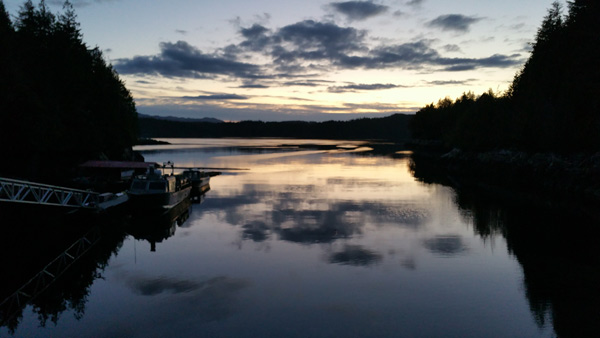
I hope you enjoyed my images. Please do not copy or post them anywhere, but feel free to post links to this page. If you are interested in purchasing high quality prints, all sizes are available.
Click here for more images from Vancouver Island, BC
|

